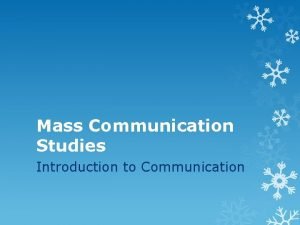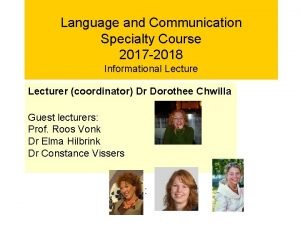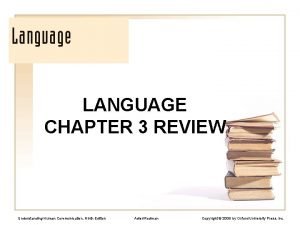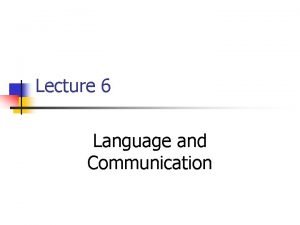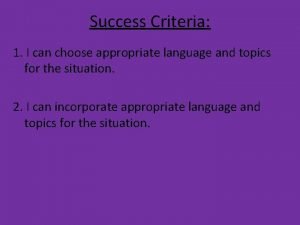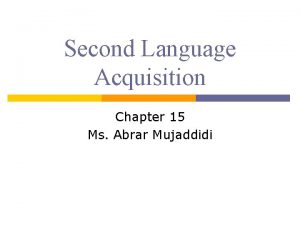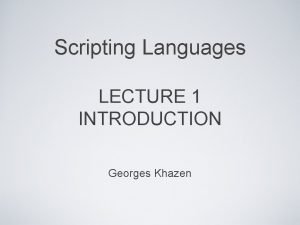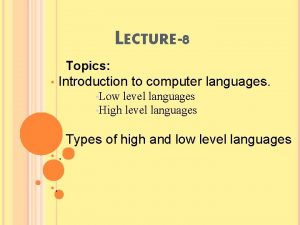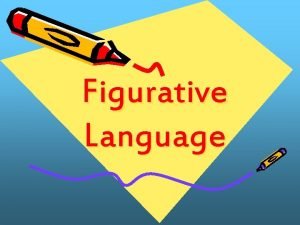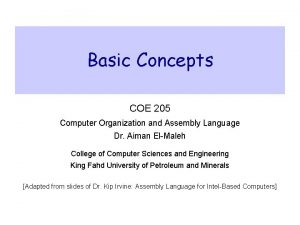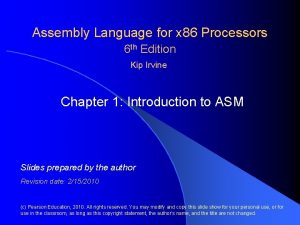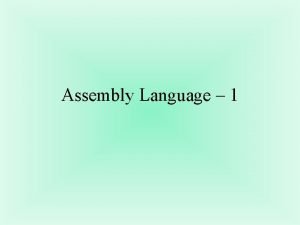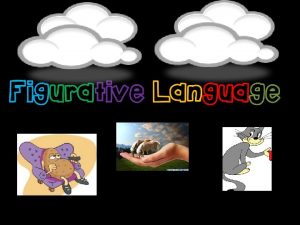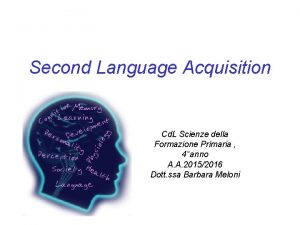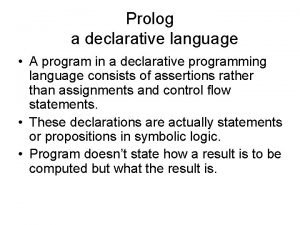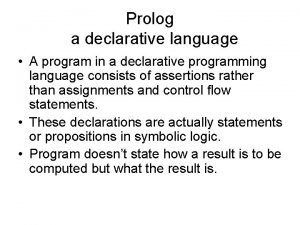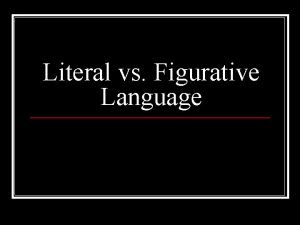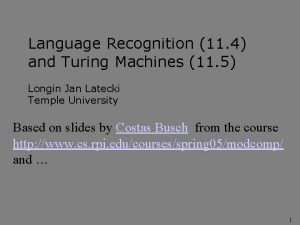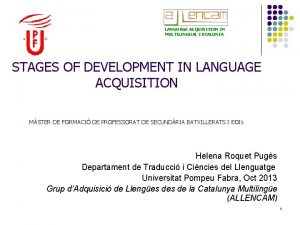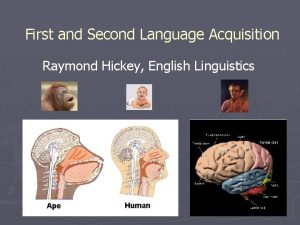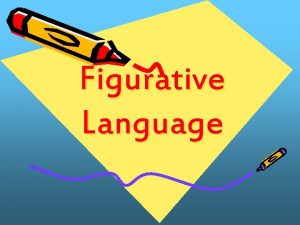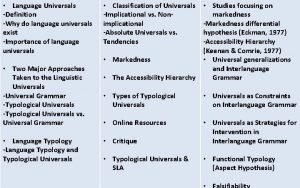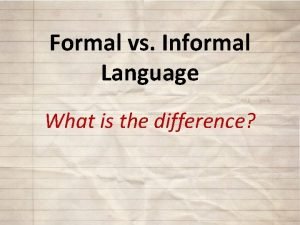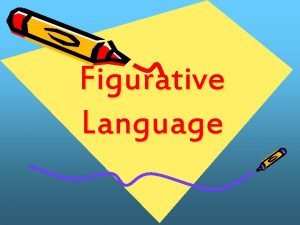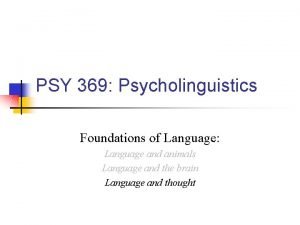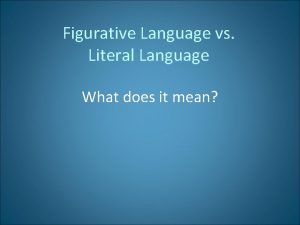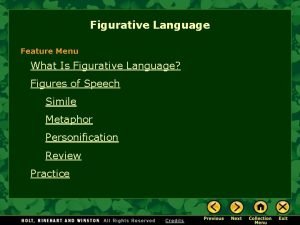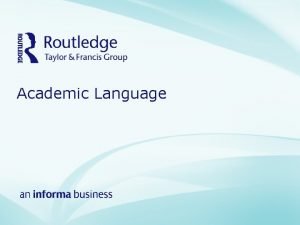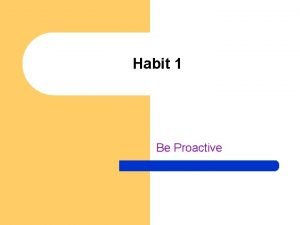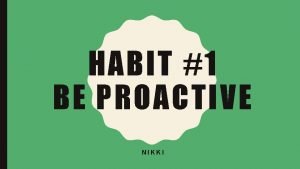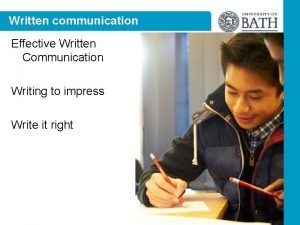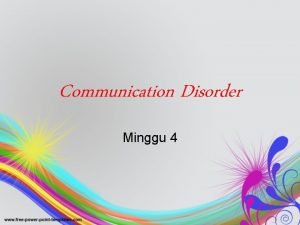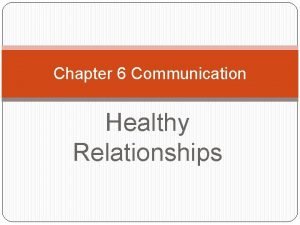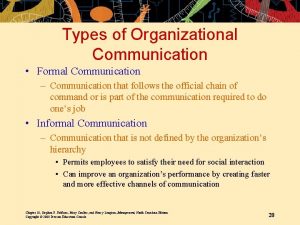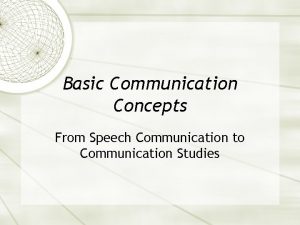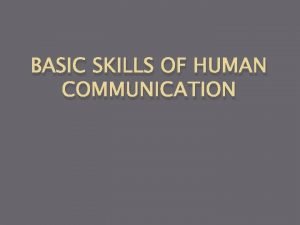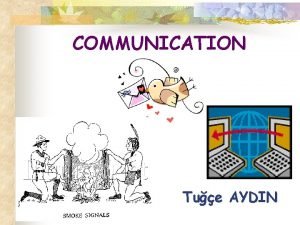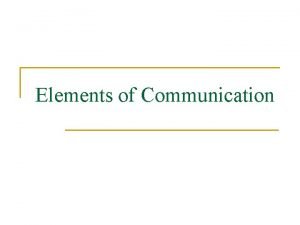What is language Language communication Is language a

















































- Slides: 49


What is language? • Language = communication? • Is language a type of communication? • Is communication a type of language? 2

Language must be composed of recognizable speech sounds? bird songs? sign language? 3

Properties of Language • • Everyone acquires language Double Articulation/Duality Arbitrary Creative Hierarchical Displacement Meaningful silence Recursion 4

Some key concepts and properties of language (1) All non-pathogenic (i. e. , normal) human beings acquire language upon exposure to a speech community. Despite the best efforts by some parents to “teach” language to their children, children acquire language at their own rate, whether their parents try to teach it to them or not. Child: Want other one spoon, Daddy. Adult: You mean, you want the other spoon. Child: Yes, I want other one spoon, please Daddy. Adult: Can you say, “the other spoon”? Child: Other…one…spoon. Adult: Say, “other”. Child: other Adult: “spoon” Child: spoon Adult: “other…spoon” Child: other…spoon. Now give me other one spoon. 5

Other forms of communication also seem to be universally acquired, however. No known instances of some bees performing waggle dances better than other bees. Lack of exposure to language: A child must be exposed to a speech community before the onset of puberty for language acquisition to take place. Genie: Child found at age 13 who had been completely sheltered from language. Her father would only make barking noises, and her mother and older brother were forbidden to speak to her at all. To this day, Genie cannot use language. She can only communicate in short sentences that lack the structure found in normal speech. 6

(2) Double Articulation/Duality Language consists of units of sound and units of meaning. SOUND MEANING cat 고양이 /kæt/ /kojaŋi/ The units of sound do not bear any meaning. They can be re-arranged to form other units of meaning (words). /ækt/ act /tæk/ tack /tækt/ tact or tacked 7

Are the units of “sound” and units of meaning divorced in other forms of communication? Hand gestures of traffic police? Bird songs? Dogs’ barks, howls and whines? (and tail movements, etc. ) 8

(3) Language is “arbitrary” This is related to Martinet’s concept of “double articulation” where the signifier (the word in a language used to refer to a concept) and the signified (the concept in question) are related by an arbitrary sequence of sounds. There is no intrinsic property of a cat that leads us to necessarily call it a “cat” SOUND MEANING die Katze el gato cat le chat 9

Sound Symbolism/Iconicity Some aspects of language do seem relate sound and meaning. Onomatopoeic words: buzz, splash, meow, 쉿, 두근두근, 땡땡땡, etc. Turkish: şıp – plop şak – clap, crack Hewbrew: yimyum – meow Basque: kukurruku – cock-a-doodle-doo Arbitrariness in animal communication? Bee’s waggle dance – which aspects are iconic and which are arbitrary? 10

(4) Language is creative You can understand or create any novel sentence. It is highly unlikely that any of you has heard the following sentence before: Last night several pink elephants flew in through my bedroom window and poured champagne into a hollowed out grapefruit. Nevertheless, you understand exactly what it means. Creativity is also found below the level of the word. Yesterday, John found a wug in the forest. You may not know what a wug is (since it’s made up), but once you do, you will automatically understand the following sentences. Yesterday, John found several wugs in the forest. This creature is rather wuggish. Mary evaluated the degree of wuggishness of this creature. 11

(5) Language is hierarchical A language does not consist of a linear sequence of words – it has internal structure. John is happy. The man over there is happy. The girl I gave $10 to is happy. Is John happy? Is the man over there happy? Is the girl I gave $10 to happy? The subject of these sentences (underlined) can be simple or complex – in either case, we move the auxiliary (boldface) over it to make a yes/no question. There is no language in the world that has a rule such as “move the auxiliary two words to the left”. 12

(5) Language is hierarchical A language does not consist of a linear sequence of words – it has internal structure. 철수가 내 사과를 먹었다. Chelswu-ka nay sakwa-lul Chelswu-NOM my apple-ACC ‘Chelswu ate my apple. ’ mek-ess-ta eat-PST-DECL 내 사과를 철수가 먹었다. nay sakwa-lul Chelswu-ka my apple-ACC Chelswu-NOM ‘Chelswu ate my apple. ’ mek-ess-ta eat-PST-DECL Move the object one word to the left? 13

(5) Language is hierarchical A language does not consist of a linear sequence of words – it has internal structure. 이 학생이 내 사과를 먹었다. i haksayng-i nay this student-NOM my ‘This student ate my apple. ’ sakwa-lul apple-ACC mek-ess-ta eat-PST-DECL 내 사과를 이 학생이 먹었다. nay sakwa-lul i my apple-ACC this ‘This student ate my apple. ’ haksayng-i student-NOM mek-ess-ta eat-PST-DECL *이 내사과를 학생이 먹었다. *i nay sakwa-lul this my apple-ACC (‘This student ate my apple. ’) haksayng-i student-NOM mek-ess-ta eat-PST-DECL 14

(5) Language is hierarchical A language does not consist of a linear sequence of words – it has internal structure. 이 학생이 i haksayng-i 내 사과를 nay sakwa-lul 이 학생이 i haksayng-i *이 *i 내사과를 nay sakwa-lul 내 사과를 nay sakwa-lul 학생이 haksayng-i 먹었다. mek-ess-ta Move the object to the left of the subject – a hierarchical unit. No rule such as ‘move a phrase one word to the left. ’ 15

Thus, languages do not make reference to the linear sequence of words, but the hierarchical structures in the language. Consider the following sentence: The girl who is playing is named Rosie. How do we make a yes/no question out of this? the girl who is playing is named Rosie? = Rosie Move the auxiliary that appears after the subject. Move the second auxiliary? Move the first auxiliary? the boy is saying that the girl is named Rosie? 16

(6) Language exhibits displacement We can talk about events in the past or future, or possible events, or counterfactual events. Last week, John and Mary went to the opera together. They thought the tenor was amazing. Next week, they will attend the opening of Carmen. It might rain tomorrow. 눈이 올둥말둥 하네요. (It may or may not snow. ) If John hadn’t hurt his leg last week, he could have run in yesterday’s race. Displacement refers to away from the here and now (in terms of time, space and truth). We can talk about things that aren’t here, that don’t happen now or aren’t true. This distinguishes human language from animal communication. Bees cannot communicate possible sources of nectar or discuss last week’s source of nectar. But they can discuss sources of nectar that aren’t present. Dogs cannot communicate their intended actions if a burglar were in the house. They can only do so if a burglar is actually in the house at the time. 17

Blackfoot – Algonquian language spoken in Montana and southern Alberta. Determiner system encodes (among other things) present vs. absent Annáhka John áako’toowa that. invisible John will. arrive ‘John will arrive. ’ Determiner encodes that John is not visible (not here). Anná John ihpomma that John buy ‘John bought something. ’ (John must be present) 18

(7) Meaningful Silence Some linguistic concepts are not paired up with a sound correspondence. John washed two glasses. John washed a glass. John washed some glass. John is a glass-washer. /-es/ - plural marker means “more than one” refers to one glass refers to a quantity of the material glass can refer to either one glass, more than one glass, or the material glass Lack of an overt marker does not imply absence of concept denoted by that marker. Other forms of communication are not known to make use of meaningful silence. 19

(7) Meaningful Silence Some linguistic concepts are not paired up with a sound correspondence. 먹었어요 – obligatory past tense reading mek-ess-e-yo eat-PST-INFORMAL-POLITE ‘ate’ 먹어요 – absence of tense marking does not indicate lack of tense… must be interpreted as present mek-e-yo eat-INFORMAL-POLITE ‘eats’ 20

(8) Recursion in language refers to the ability to embed smaller structures in larger structures repeatedly. John’s hat John’s brother’s baby’s hat This is the house that Jack built. This is the malt that lay in the house that Jack built. This is the rat that ate the malt that lay in the house that Jack built. This is the cat that killed the rat that ate the malt that lay in the house that Jack built. This is the dog that worried the cat that killed the rat that ate the malt that lay in the house that Jack built. etc. 21

Recursion A sentence is typically composed of a subject and a predicate: predicate subject John ate the apple. Mary left the room. S – sentence NP – noun phrase S VP – verb phrase NP John VP ate the apple S NP VP 22

Recursion VP often consists of a verb and a direct object (another NP) report a crime, a robbery, a story, a piece of gossip NP VP V NP S report that John left work early, that the knives were missing, that a fire broke out, that it might rain later on Now we can see how recursion comes about: S NP VP and VP V S The ‘S’ inside the VP itself contains an NP and VP 23

Recursion Now we can see how recursion comes about: S NP VP and VP V S The ‘S’ inside the VP itself contains an NP and VP John reported a crime. John reported that Mary witnessed a crime. John reported that Mary heard that Susan told Bill that Alice thinks that… John’s sister’s friend’s brother’s piano teacher … 24

Recursion Limits on recursion: Recursive structures do not go on forever People need to breathe, eat and sleep, etc. Listener may get bored or confused and walk away if speaker keeps going on… Once upon a while back there was an ambitious contortionist who made up his mind he would try to conquer the twenty -seventh highest dead volcano on Neptune, with his tongue secretly hiding behind his overweight postman’s Swedish Hi -Fi set and the shoelaces of his Persian Ugh boots stubbornly caught on the corner of the round Toongabbie equestrian sports complex, while he would try to breed miniature brown cicadas inside a quickly rotating water-heater with seven silk pillowcases hanging from his uneducated vacuum cleaner which would be chained around his navel, and ask if his second grand-stepfather has heard of any orange-flavoured Portuguese atomic submarines in the neighbourhood lately that have precisely half of their crews attempting to break the 1958 record for mass voluntary electrocution whilst being sponsored by the dangerous chrysanthemum division of Interflora, who have recently gone bankrupt due to the discovery of an overcrowding of rebellious screwdrivers in the Martian stratosphere last week, when salamanders controlled nine hours forty-seven minutes of the 1978 Pakistani croquet final between the lower Philadelphia fishmonger recruiting officer and Karl Marx’s younger brother Harpo, who has not seen his bedroom since the Mexican figureskating champion booked fourteen tomatoes for exceeding the post-war speed limit and lost his balance whilst trying to hunt abominable snowmen at the Olympics with a soggy sultana hidden inside his chaperone’s nightshirt which, in 1947, when John Lennon first washed his face and socks in the same country, had its only steel-plated sleeve melted off by the self-appointed chairman of Doubtful Drainpipes Destruction Company under the New Moscow Harbour Bridge which is, at present, rusting severely, due to a heavy downpour of talcum powder over at Disneyland also due to sixteen undernourished lizards going into a deep, meditating coma without asking their mothers, who were not about to 25 stand for this caper and sat down immediately, squashing Winston Churchill’s scale model of Albert Einstein’s theory of relativity, which…

Recursion Are the limits on recursion a property of language itself? Or are the limits on recursion merely a by-product of external factors (such as the need for clarity and conciseness)? Pragmatic limits on recursion? Is pragmatics part of the language faculty? Shampoo directions: 1. lather 2. rinse 3. repeat Or is this just common sense? 26

Grammaticality and Acceptability Numbers here indicated co-reference. (1) a. John 1 thinks that Mary likes him 1. b. John thinks that Mary 2 likes herself 2. c. * John 1 thinks that Mary likes himself 1. d. * John thinks that Mary 2 likes her 2. * = unacceptable to a native speaker 27

Linguistics = study of language What is a language? 28

Language versus Dialect • If two distinct speech forms are mutually unintelligible they are two distinct languages. • If two distinct speech forms are mutually intelligible, they are two dialects of the same language. 29

This sounds easy enough, but what about the following scenario: Three towns, 10 km apart: A B C O-----------------------------------O People from town A can understand people from town B People from town B can understand people from town C BUT, people from town A cannot understand people from town C We call this a dialect continuum, and they are quite common around the world. One famous one is the Dutch/German dialect continuum. Someone from Amsterdam and someone from Munich cannot understand each other – but people from the smaller boarder towns on the Dutch/German border can understand one another. Another dialect continuum is Cree is spoken from Alberta to Quebec, but not all dialects are mutually intelligible. Neighbouring dialects tend to be mutually intelligible, but dialects that are spoken in communities far apart tend not to be. 30

Is Chinese a language? Linguistically, Chinese is a subfamily of languages (it is a branch of the Sino-Tibetan family) The most widely spoken Chinese language is Mandarin (northern China and Taiwan). Another familiar Chinese language is Cantonese (Hong Kong and Guangdong province). A 10 -year-old child from Beijing and a 10 -year-old child from Hong Kong will not understand a word the other is saying – thus, Mandarin and Cantonese are two different languages. However, Mandarin is the official language of China. Sometimes, Mandarin is simply referred to as “Chinese”. Because of the official status of Mandarin, all the other Chinese languages are sometimes referred to as “dialects” – but this is a different use of the word “dialect” than described above. In this course, we will use the terms we introduced above. 31

How does one form of the language become the standard? A COMMON MYTH: REALITY 32

Koreanic Two members: Korean and Jeju https: //www. youtube. com/watch? v=f. QCm. BGrx 1 UQ Altaic Hypothesis – Not universally accepted…still bitterly debated 33

Sprachbund • A sprachbund is a geographically related group of languages which share common features, but are not all genetically related. • Balkan Sprachbund – included Romanian (Romance), Bulgarian (Slavic), Greek (Hellenic), and Albanian (Albanian) 34

Sprachbund • Thai, Vietnamese, Sino-Tibetan • Northwest Coast Sprachbund (from California to Alaska) – includes Salish, Wakashan and Chimakuan languages 35

Descriptivism: The practice of describing, analyzing and understanding how language is used This includes language in all its forms, including its dialects (the form of a language used in a geographically determined area), sociolects (the form of a language used by a given socio-economic class) and even idiolects (the particular form of a language used by a specific person). This is the approach followed by most linguists. …and in Korean 옷이 예쁘십니다 os-i yeyppu-si-p-ni-ta cloth-NOM pretty-HON-FORMAL-IND-DECL ‘The clothes are nice. ’ 시 – addressee honorific? 36

The litmus test here is the native speaker’s intuitions. Compare the following: Who do you think Peter likes? Who do you think that Peter likes? Who do you think likes Peter? * Who do you think that likes Peter? The last sentence is not one you’ll hear a native speaker of English say. We say that this sentence is ungrammatical. We mark it with an asterisk. namwuskaci-ka tree. branch-nom ‘The tree branch broke. ’ kkekk-i-ess-ta snap-inch-pst-decl elum-i ice-nom ‘The ice melted. ’ nok-ass-ta melt-pst-decl *elum-i ice-nom ‘The ice melted. ’ nok-i-ess-ta melt-inch-pst-decl 37

This brings us to an important point. Parity of language. From a linguistic perspective, no language or dialect is “better” than another one. In other words, we cannot say one language or dialect is better able to express a concept or more suitable for a given topic or that a given utterance is “wrong” from a linguistic point of view. Imagine you’re watching a nature program on TV that’s showing birds building nests. narrator: “As you can see, the bird interweaves the pieces of bark counter-clockwise and secures the pieces with stomach secretions… imagine the following continuation “However, the bird is building the nest wrong. It should weave the pieces of bark clock-wise and use mud to secure the pieces of bark…” It is clear that it is not the job of zoologists to tell animals how to behave in the wild. They simply describe how they do behave and analyze their behaviour. Likewise, it is not the job of a linguist to tell people how to speak, we simply describe how people use language and analyze it. 38

Prescriptivism: The practice of dictating, by virtue of some authority, acceptable standards of language use. Linguists are interested in a descriptive approach – The way people actually use language tells us something about how the human mind works. Prescriptive approaches are what most of us are familiar with. Editors, for example, are interested in prescriptive approaches to the study of language. Prescriptivist attitudes are most often applied to written language, but are often applied to spoken language. Examples of prescriptive authorities (with varying degrees of qualifications) include the Academie Française, Oxford English Dictionary, Chicago Manual of Style, Ann Landers, your high-school English teacher and so forth. 39

In the case of English, prescriptive rules had another source – Latin In the mid 19 th century, some writers such as Dryden and Swift sought to “fix” the English language (i. e. , keep it from changing) by introducing rules from Latin into English. Latin was perceived as a “perfect” language. Unfortunately, some rules of Latin are unsuited for English. Take the sentence above. Who did you go to the movies with? There is a prescriptive rule against stranding prepositions like this. The sentence should read With whom did you go to the movies? The reason for this rule is simple. Latin doesn’t strand prepositions, so English shouldn’t, either. However, preposition stranding (sentences such as (6)) have been used in the language for over 700 years. But…how about the following: A good writer should have a clear idea of who she is writing for. A good writer should have a clear idea of for whom she is writing. 40

Another well-known kind of example is the following: Someone forgot their umbrella on the bus. A prescriptivist approach holds that someone is singular and should have a singular descendent. The sentence, then, should read as follows: Someone forgot his umbrella on the bus. In fact, some people will severely admonish you for using generic or singular ‘they’. The truth of the matter is that generic ‘they’ (or ‘their’ as in the sentence above) has been around since the word ‘they’ was borrowed into English. (It may surprise you to find out that they was not originally an English word – it was borrowed from Scandanavian). Almost immediately after it was borrowed into English, it was used as in the sentence above – the way we still use it today. It can be found in the works of Shakespeare and Austen. In the 1850’s, however, a few scholars at the time decided that generic ‘they’ should not be used. The upshot is this – languages and dialects do not have any inherent (positive or negative) value, linguistically speaking. From a linguistic point of view – all 41 languages and dialects are equal.

Universal Grammar (UG) • Language is unlike mental capacities (such as mathematics or the ability to explicate a poem) in that is doesn’t require any conscious effort on the part of the child to acquire it. • Children do not sit and memorize lists and lists of irregular verbs, for example. • Language instruction, if present at all, is scant and generally ineffective. 42

Universal Grammar (UG) • Language is more like other physiological properties of human (such as going through puberty, or growing limbs) in that it happens naturally to the child when exposed to appropriate environment (namely, a speech community). • It is natural to ask, then, “Are some properties of language innate or hardwired? ” 43

How does the child uncover the complexity of human language? Poverty of the Stimulus – The input the child receives is too impoverished to determine the rules of their language. Example: parasitic gaps Which files did you put away without reading __ ? (compare: Which files did you put away without reading them? ) The first sentence contains a ‘parasitic gap’ – the precise details are unimportant. What is important is that this sentence is grammatical. Consider now the following sentences. *Which teacher punished you for hitting __ in the face? (compare: Which teacher punished you for hitting them in the face? ) Somehow, we just know that certain constructions allow parasitic gaps and others don’t. We’ve never received instruction on this, nor are examples of parasitic gaps prevalent enough for us to figure them out. 44

Kids (don’t) say the darndest things… Jamie was climbing a tree one day. When he was near the top of the tree, he fell and bruised his arm. Later on that day, he was having a bath. His father walked in and asked, “What happened to your arm? ” Jamie answered back, “I hurt it climbing a tree earlier. ” 45

When did Jamie say he hurt his arm? When he was climbing the tree. When he was having a bath. When did Jamie say how he hurt his arm? When he was having a bath. *When he was climbing a tree. Children never offer this response How do we know that this is not a possible response? 46

Universal Grammar • UG = that part of language that is invariant across the species (humans) • Predicts the presence of some properties that are universal in all languages. • Much current research focuses on determining which aspects of language are truly universal, and which vary across languages. 47

Children do not learn language by analogy It has been suggested that children learn language by analogy. This seems like a reasonable possibility given the large variety of generalizations that can be made about grammar. For instance, the first analogy the child could draw is that direct objects are always place after verbs. This would account for the two-word stage during language acquisition, which consists usually of sequences of a verb and a direct object. Under this approach, there is no underlying universal grammar. The child simply learns language the same way he or she learns any other aspect of life. Consider, however, the following examples (Gleitman, 1994). Susan painted the red barn. Susan painted the barn red. Susan saw the red barn. *Susan saw the barn red. 48

Children do not learn language by analogy Under the analogy approach it is expected that children would produce speech errors during acquisition along the lines of the last example – however, children never seem to produce errors of this kind. This is unexpected assuming that children make use of analogies during language acquisition, but is compatible with an approach that assumes UG. In short, UG doesn’t make structures available that could produce the last sentence, which is why children never make errors of this kind. 49
 Parallel communication vs serial communication
Parallel communication vs serial communication What is oral communication and written communication
What is oral communication and written communication Serial and parallel communication
Serial and parallel communication What is mass communication
What is mass communication Diff between oral and written communication
Diff between oral and written communication Serial communication vs parallel communication
Serial communication vs parallel communication Speech act theory
Speech act theory Language and communication examples
Language and communication examples How long does a free verse poem have to be
How long does a free verse poem have to be Delivery language in communication
Delivery language in communication Equivocal language in communication
Equivocal language in communication Introduction of means of communication
Introduction of means of communication What is communication
What is communication Language
Language What is language acquisition
What is language acquisition Difference between second language and foreign language
Difference between second language and foreign language Strongly typed scripting language
Strongly typed scripting language Differences between home language and standard language
Differences between home language and standard language Low level languages
Low level languages Hardware description language vs programming language
Hardware description language vs programming language Figurative vs literal language
Figurative vs literal language Assembler in computer
Assembler in computer Difference between assembly language and machine language
Difference between assembly language and machine language Language
Language Languagen
Languagen Formal vs informal vocabulary
Formal vs informal vocabulary What is the language in
What is the language in Prolog declarative
Prolog declarative Prolog is a declarative language.
Prolog is a declarative language. Literal vs figurative examples
Literal vs figurative examples Turing machine
Turing machine Difference of first language and second language
Difference of first language and second language Difference of first language and second language
Difference of first language and second language Allusion meaning
Allusion meaning Levels of language knowledge
Levels of language knowledge Language universals meaning
Language universals meaning Formal and informal language difference
Formal and informal language difference Literal vs figurative language examples
Literal vs figurative language examples Language language
Language language Reactive language vs proactive language
Reactive language vs proactive language Figurative language vs literal language
Figurative language vs literal language Is figurative language a language feature
Is figurative language a language feature What was the first human language
What was the first human language Social language vs academic language
Social language vs academic language Proactive people make choices based on
Proactive people make choices based on Proactive vs reactive language
Proactive vs reactive language Xxxfirm
Xxxfirm Effective written communication
Effective written communication What is memorandum in business communication
What is memorandum in business communication Why is communication important in the workplace
Why is communication important in the workplace



